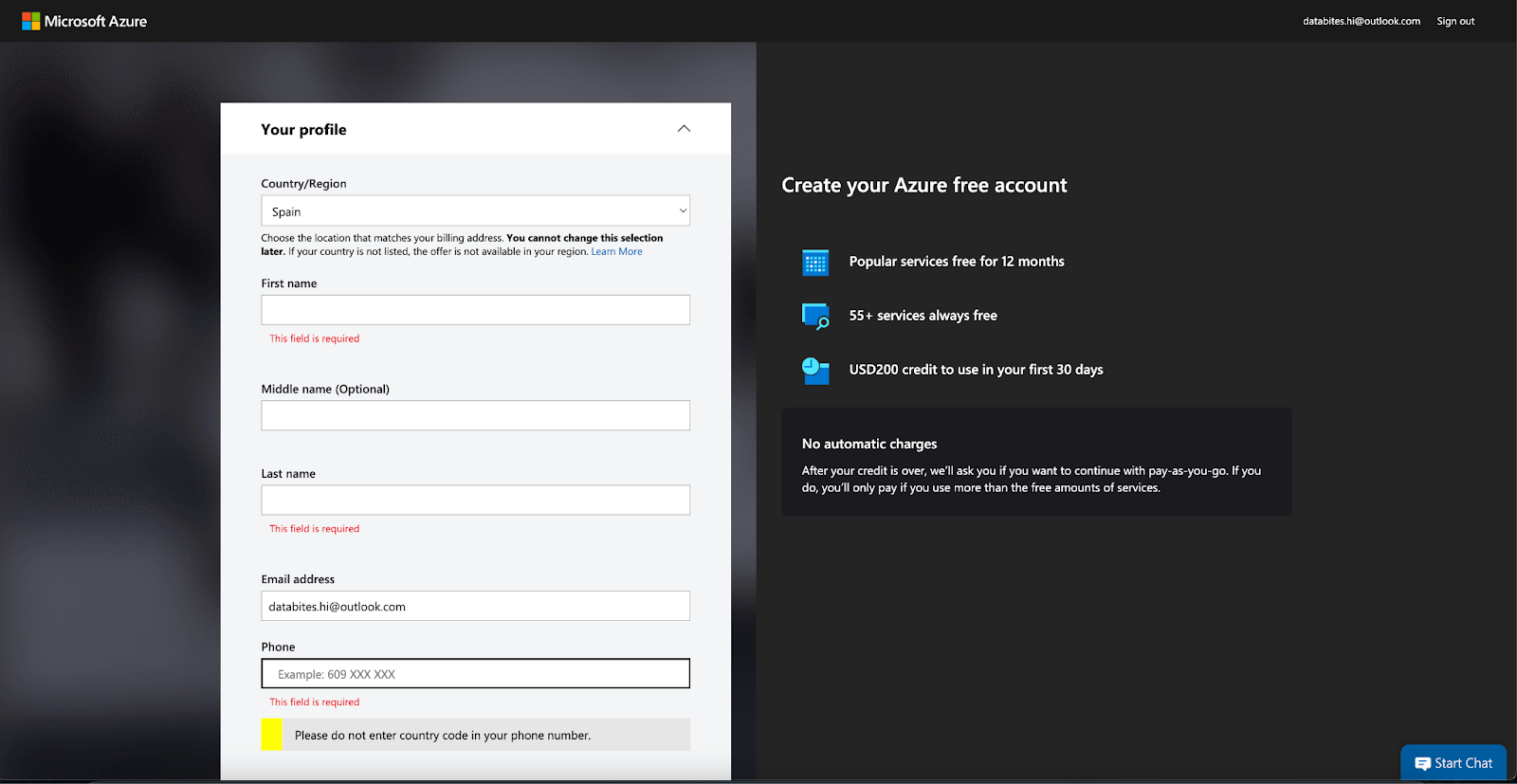Track
Professionals with solid foundations in Microsoft Azure are in high demand. This is because around 25% of all tech professionals use Azure Cloud Services in their daily work according a Stack Overflow survey in 2024, making Azure one of the biggest cloud services providers together with AWS and GCP.
To remain competitive, familiarizing yourself with at least one major cloud platform is a must—and Azure is an excellent choice. However, I know how daunting starting with any new technology can feel. This is why today I want to help you navigate the journey of learning Azure, from understanding its basics to hands-on projects, together with links to some resources to help you get started now.
Still not sure if Azure is right for you?
Let’s explore the benefits and answer your biggest questions. And if you think it's a fit and I want to get started, I recommend our Understanding Microsoft Azure course as a good first choice.
Why Learn Azure?
Learning Microsoft Azure and having some solid foundations in it might have three main positive advantages for you:
It accelerates career growth
First and foremost, learning Azure will jumpstart your career:
- High Demand: Azure is a leader in cloud computing, and there is demand for professionals skilled in its ecosystem. Learning Azure puts you in a good spot with recruiters.
- Higher Salaries: Certification in Azure validates your knowledge and allows you to get higher-paying roles and promotions.
- Wider Horizon: With Azure’s broad applications, from AI to DevOps, you’ll gain a versatile skill set that keeps your career options open.
It has many applications
Azure powers innovation across industries with tools and services. Here are just a couple of the many applications:
- Virtual Machines: You can deploy scalable, secure computing environments.
- AI and Machine Learning: You can build intelligent apps with Azure AI Services.
- Data Analytics: You can use Azure’s analytics tools for insights.
It gives you a competitive edge
You’ll gain a unique advantage in the job market:
- Resume Boost: Azure certifications make you stand out to employers and demonstrate commitment to professional growth.
- Future-Proof Skills: Having a solid domain of an ever-needed skill makes you stay ahead and remain necessary in the job market.
- Personal Growth: Tackle challenges, expand your knowledge, and position yourself as a forward-thinking professional.
Master Azure From Scratch
So now that you already know the main advantages that learning Azure might bring to your professional life, let’s further understand how it works.
Key Azure Features Worth Learning
Azure combines scalability, integration with Microsoft tools, and a vast global network of data centers. Its ecosystem has 5 main features:
- Scalability: You don’t have to worry about significant hardware investments. Azure services allow you to add or remove resources based on your current needs.
- Flexibility: You can modify infrastructure as your needs change over time.
- Advanced security: Azure solutions offer top-notch security features, such as automatic backups and disaster recovery capabilities.
- Cost-effective: Azure solutions offer a pay-as-you-go pricing model, which means you only pay for what you use.
- Data sharing and collaboration: Using cloud-based services like Azure fosters data sharing and collaboration, allowing different teams and stakeholders to access and analyze data securely.
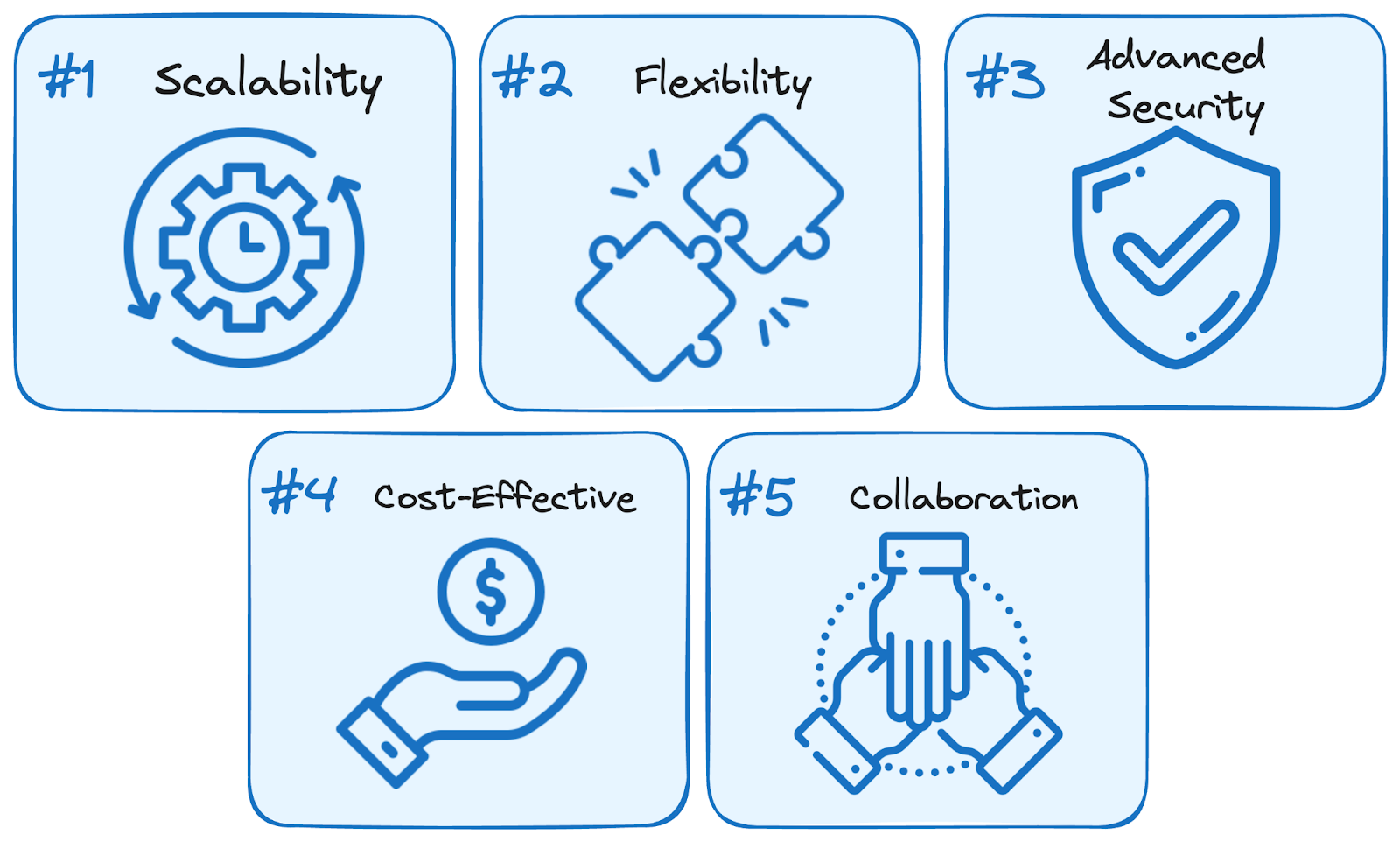
Advantages of using Azure. Image by Author.
Core services
Azure provides a suite of services to support development, deployment, storage, and intelligence in the cloud.
- Compute Services: Deliver scalable, on-demand processing power for tasks like app deployment and development with solutions like Virtual Machines, Azure App Service, and Kubernetes (AKS).
- Storage Solutions: Offer scalable and secure cloud storage for diverse data types, including blob, file, and disk storage options.
- Database Offerings: Provide flexible, managed database solutions like Azure SQL Database, Cosmos DB, and Azure Database for MySQL.
- AI and Machine Learning: Empower solutions through tools like Azure Machine Learning and Cognitive Services.
- Networking: Provides seamless, secure communication across cloud and on-premises systems with Virtual Networks, VPN Gateways, and Load Balancers.
As you can see, Azure's ecosystem delivers the tools you need to build, scale, and innovate efficiently in the cloud.
So now, let’s start with the real fun of answering today’s main question:
How to Start Learning Azure
Let's start by asking why exactly you might want to learn Azure because how you answer that question can change the direction of what exactly you learn and how you go about learning it.
Understanding why you want to learn Azure
Let's take a moment to identify your objectives:
Are you aiming for a role in development, data analysis, or IT operations?
Understanding your goals helps you align with the right learning paths and focus on the Azure services most relevant to your career aspirations. Furthermore, you should know that Microsoft offers a structured certification path for each role.
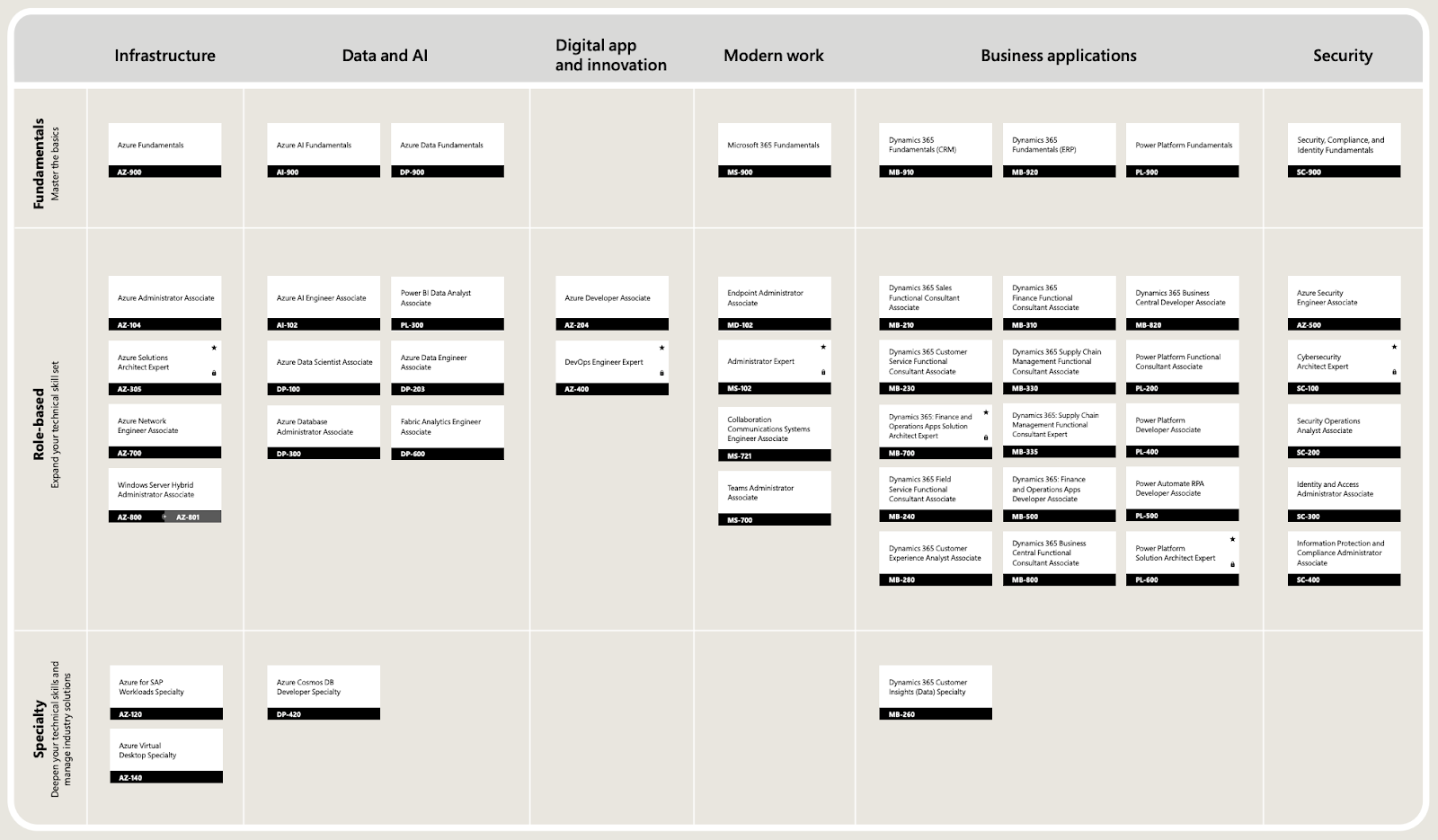
Azure learning paths. Source: Microsoft
- Infrastructure Roles: Manage and design cloud systems with certifications like Azure Administrator (AZ-104) or Solutions Architect (AZ-305).
- Data & AI Roles: Dive into data and machine learning with Data Engineer (DP-203) or AI Engineer (AI-102).
- Development Roles: Build and deploy apps with Developer Associate (AZ-204) or DevOps Expert (AZ-400).
- Business Applications: Master enterprise tools with Power Platform Developer (PL-400) or Dynamics 365 certifications.
- Security Roles: Strengthen security expertise with Security Engineer (AZ-500) or Cybersecurity Architect (SC-100).
If you are new to this ecosystem, you should always begin with Fundamentals certifications to build a strong base, then progress to the role-based or specialty certifications. I strongly recommend the Azure Fundamentals Certification course we offer here at DataCamp which was built in partnership with Microsoft.
Getting started
The first step is to create your Microsoft account and activate Azure. This is your gateway to exploring and using what Azure has to offer.
Setting up an Azure Storage account
To get started with Azure, just like any other online service, the first thing is creating an account and signing in. You will find a step-by-step guide to do so:
Step 1: Sign in to the Azure Portal
Sign in to your Azure account at portal.azure.com.
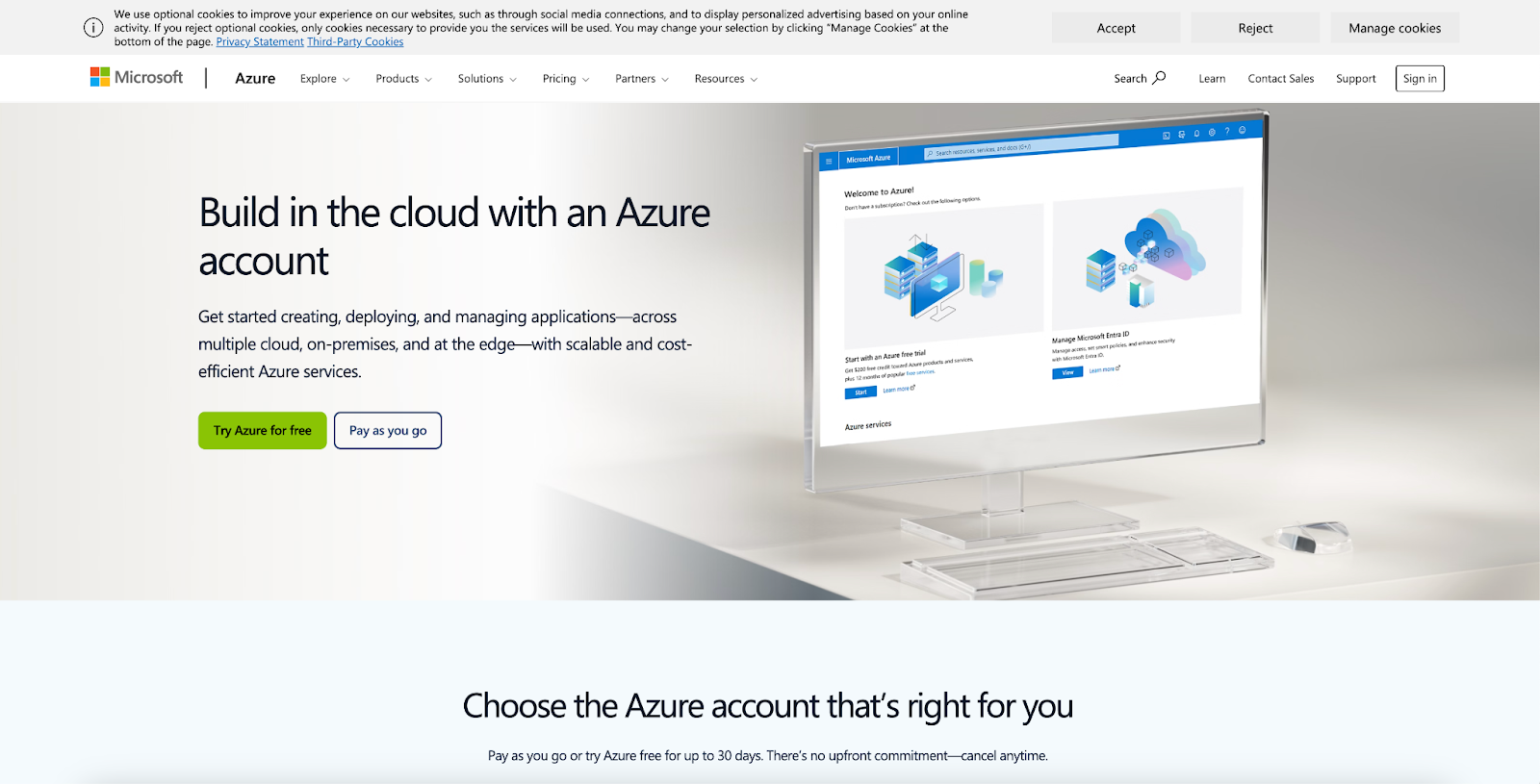 Screenshot of Azure landing website.
Screenshot of Azure landing website.
Step 2: Add your billing information and your details
Once you click on the Get Started button, you will have to share your details (including name, surname, and billing information) to activate your account.
Screenshot of Azure landing website. Image by Author
Once you have an active account, you will get into your Azure main view. You should see something similar to the following image.
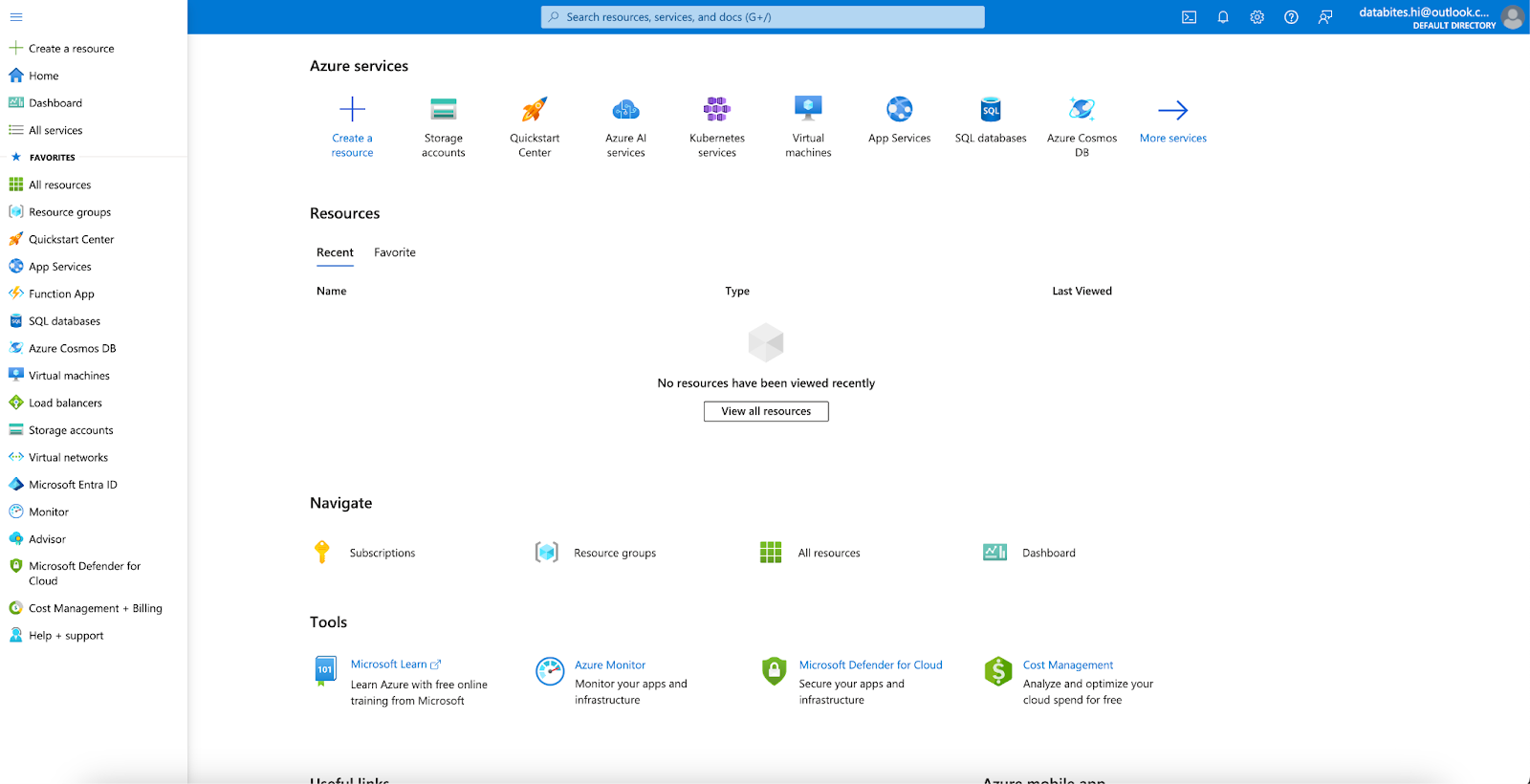
Screenshot of Azure main view. Image by Author
Begin with the Azure Portal
Once your account is set up, log in to the Azure portal, the central hub for managing your Azure resources. Familiarize yourself with:
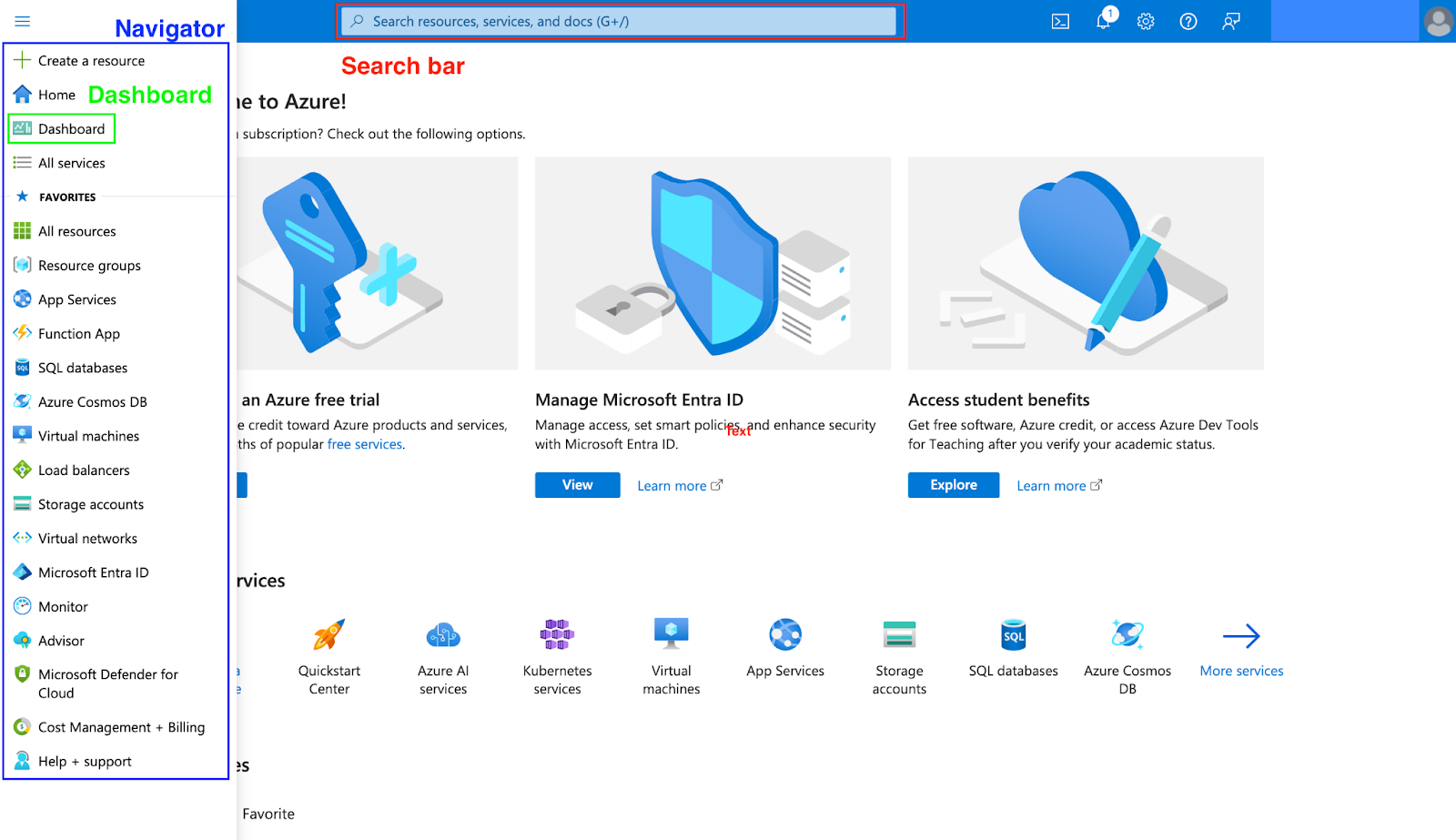
Azure main view with Menu Navigator, the Dashboard, and the Search Bar. Image by Author.
- Dashboard: Customizable to show your key resources and metrics.
- Menu Navigation: Access services like Virtual Machines, Storage, and Databases using the navigator of the azure website.
- Search Bar: Quickly find tools or services.
Learn core concepts
Now it's time to make sure you understand Azure fundamental concepts. Start with these:
- Subscriptions: Define the billing scope and resource management.
- Regions: Explore Azure’s global data centers and select regions based on your needs.
- Resource Groups: Organize resources logically for easier management and tracking ordered in resource groups.
With your goals defined and foundational knowledge in place, you're ready to start building your expertise.
Azure Learning Pathway
Step 1: Master Azure fundamentals
Azure Core Services
Microsoft Azure offers a broad range of core services to meet diverse business needs, spanning compute, storage, networking, and others. To keep you organized, I'm going to list here the eight essential Azure services to start with.
Because there's a lot of detail in each service, and because it would be beyond the scope of this learning guide to talk about each one at length, I'm going to make sure to link the official documentation in each place.
1. Azure Virtual Machines (VMs): Virtual Machines are Azure's core computing resource, allowing users to run applications in the cloud without owning physical servers.
- Key Uses: Development and testing environments, hosting web apps, and processing high-performance tasks.
- Why It’s Important: VMs provide flexibility, scalability, and control over configurations like memory, CPUs, and storage.
2. Azure App Services: Azure App Sercices is a platform-as-a-service (PaaS) for hosting web applications, RESTful APIs, and mobile app backends.
- Key Features: Supports multiple programming languages, integrates with DevOps tools, and offers autoscaling for traffic spikes.
- Why It’s Important: Simplifies web and app development by managing infrastructure, enabling developers to focus on coding.
3. Azure Blob Storage: Azure Blog Storage is a scalable object storage service for unstructured data like images, videos, and backups. I wrote a complete guide on this one specifically: The Complete Guide to File Storage on Azure with Blob & Files.
- Key Uses: Content delivery, data archiving, and disaster recovery.
- Why It’s Important: Offers tiered pricing for cost efficiency and integrates seamlessly with other Azure services.
4. Azure SQL Database: Azure SQL Database is a fully managed relational database service for applications requiring scalable and secure data storage.
- Key Features: Automated scaling, advanced security, and performance monitoring.
- Why It’s Important: Ideal for businesses needing a reliable database solution with minimal maintenance.
5. Azure Active Directory (Azure AD): Azure AD is a cloud-based identity and access management service that centralizes user access across cloud and on-premises applications.
- Key Features: Single sign-on (SSO), multi-factor authentication, and secure access control.
- Why It’s Important: Enhances security while simplifying identity management for organizations.
6. Azure Kubernetes Service (AKS): AKS is a managed service for deploying and managing containerized applications using Kubernetes.
- Key Uses: Running microservices, scaling workloads, and implementing DevOps practices.
- Why It’s Important: Simplifies Kubernetes management, allowing teams to focus on app development.
7. Azure Functions: Azure Functions are a serverless compute service that runs event-driven code in response to triggers like HTTP requests or database changes.
- Key Uses: Real-time data processing, scheduled tasks, and lightweight API development.
- Why It’s Important: Allows efficient execution of small code snippets without managing servers.
8. Azure Cognitive Services: Azure Cognitive Services is a collection of AI tools and APIs for adding intelligent features like facial recognition, natural language processing, and speech analysis to applications.
- Key Uses: Creating smarter, user-centric applications with minimal AI expertise.
- Why It’s Important: Democratizes AI for developers, enabling rapid integration of advanced capabilities.
Azure CLI and PowerShell:
Once you’re familiar with the core services, mastering Azure’s management tools can significantly enhance your efficiency and productivity.
- Azure CLI: A cross-platform command-line tool for managing Azure resources, ideal for automating tasks and integrating with CI/CD workflows.
- Azure PowerShell: A scripting tool for Windows environments, enabling advanced automation and unified management of Azure and on-premises resources.
By combining foundational knowledge of Azure’s core services with powerful management tools like CLI and PowerShell, you’ll be well-equipped to optimize your Azure experience and streamline cloud operations.
If you want to get started now with the fundamentals of Azure, just start DataCamp’s Understanding Microsoft Azure course to get a general overview of the platform.
Step 2: Get hands-on with Azure
The best way to start learning a new skill is by doing, and Azure is no exception. Once you’ve mastered the basics, the next step is to start building real-world projects. These projects not only solidify your knowledge but also contribute to a portfolio that demonstrates your skills and growth.
Building your portfolio with Azure projects
Below are project recommendations based on skill levels to help you get started:
Beginners
Start simply by setting up a virtual network or deploying a basic app. For instance, deploying a Basic Web App.
Overview: Deploy a simple web application using Azure App Service. This project involves creating a basic HTML or ASP.NET app and publishing it to Azure.
Steps:
- Set up an App Service plan.
- Adjust application settings.
- Deploy your code through Azure DevOps or GitHub.
Start Here: Hosting Your First Web Application on Azure App Service.
Intermediate
Challenge yourself by building a multi-tier application, integrating databases, or experimenting with Azure IoT Hub. For instance, Setting Up an SQL Database.
Overview: Set up and configure an Azure SQL Database to familiarize yourself with SQL and database management in Azure.Steps:
- Create an SQL Database server.
- Set up database instances.
- Perform tasks like creating tables, adding data, and running queries.
- Learn to scale and manage databases effectively.
Start Here: Azure SQL Database Step-by-Step Setup and Management.
Advanced
Tackle complex projects like creating a scalable web app with Kubernetes or building an end-to-end data pipeline. For instance, Developing a Big Data Solution
Overview: Build a big data solution using Azure Synapse Analytics to analyze large datasets and generate insights.
Steps:
- Set up a data lake to store vast amounts of data.
- Use Synapse Analytics for data processing.
- Build dashboards for data visualization.
Start Here: Build A Data Lake Solution Using Azure Synapse Analytics.
Showcasing your skills
Documenting and presenting your projects is just as important as building them. Use GitHub or a personal website to:
- Provide detailed descriptions of each project, including objectives, tools used, and outcomes.
- Share code repositories with clear documentation to make them accessible to others.
- Include visuals such as screenshots, diagrams, or dashboards to illustrate results.
- Write a blog post or project summary to highlight challenges, solutions, and key learnings.
By combining hands-on experience with a polished portfolio, you’ll effectively demonstrate your expertise and stand out in the competitive Azure ecosystem.
Step 3: Deepen your skills in specific services
We already saw Azure has a wide range of certifications. This is why, there are multiple sources for each of them.
Recommended resources to get started
Here are some recommended resources. I divided these by role, so please scroll to the role that interests you most.
1. Infrastructure roles
| Category | Details |
|---|---|
| Certifications | Azure Administrator (AZ-104) Solutions Architect (AZ-305) |
| Learning Paths | Azure Administrator Learning Path Azure Solutions Architect Learning Path |
| Books | Exam Ref AZ-104 Microsoft Azure Administrator by Harshul Patel Exam Ref AZ-305 Designing Microsoft Azure Infrastructure Solutions by Santiago Fernández Muñoz |
| Practice Labs | Use platforms like Whizlabs or A Cloud Guru for hands-on infrastructure tasks. |
2. Data & AI Roles
| Category | Details |
|---|---|
| Certifications | Data Engineer (DP-203), AI Engineer (AI-102) |
| Learning Paths | Azure Data Engineer Learning Path Azure AI Engineer Learning Path Introduction to Data Engineering course by DataCamp |
| Books | Exam Ref DP-203 Data Engineering on Microsoft Azure by Daniel A. Seara and Francesco Milano Exam Ref AI-102 Designing and Implementing an Azure AI Solution by Pablo Alejandro Garcia and Julius G. Gidwani |
| Hands-On Resources | Azure Machine Learning Studio Tutorials Data Engineering labs from Databricks Academy |
3. Development Roles
| Category | Details |
|---|---|
| Certifications | Developer Associate (AZ-204), DevOps Expert (AZ-400) |
| Learning Paths | Azure Developer Associate Learning Path Azure DevOps Expert Learning Path DevOps Concepts course by DataCamp |
| Books | Exam Ref AZ-204 Developing Solutions for Microsoft Azure by Santiago Fernández Muñoz Exam Ref AZ-400 Designing and Implementing Microsoft DevOps Solutions by Guruprasad Venkatraman and Steve Ross |
| Hands-On Resources | GitHub repositories with Azure CI/CD examples Build cloud-native apps with Microsoft's Azure App Services Guide |
4. Business Applications
| Category | Details |
|---|---|
| Certifications | Power Platform Developer (PL-400) Dynamics 365 Certifications |
| Learning Paths | Power Platform Developer Learning Path Dynamics 365 Certification Learning Paths |
| Books | Microsoft Power Platform Functional Consultant Exam Ref PL-200 by Julian Sharp Exam Ref MB-300 Microsoft Dynamics 365 Core Finance and Operations by Faisal Akkawi |
| Hands-On Resources | Explore Microsoft Learn Power Platform modules for interactive tutorials Use the Dynamics 365 free trial for practice |
5. Security Roles
| Category | Details |
|---|---|
| Certifications | Security Engineer (AZ-500) Cybersecurity Architect (SC-100) |
| Learning Paths | Azure Security Engineer Learning Path Cybersecurity Architect Learning Path |
| Books | Exam Ref AZ-500 Microsoft Azure Security Technologies by Yuri Diogenes and Orin Thomas Exam Ref SC-100 Microsoft Cybersecurity Architect by Dwayne Natwick |
| Hands-On Resources | Microsoft Defender Labs for security practice Azure Sentinel practice via Microsoft’s Security Labs |
Azure Learning Resources
Here are some resources you can keep in mind when you are learning:
Courses and tutorials
For a structured approach to learning Azure, consider the following platforms that offer beginner-to-advanced level courses tailored to various roles and certifications:
- Microsoft Learn: A free, interactive platform offering guided learning paths and hands-on labs for all Azure certifications and services.
- DataCamp: We offer courses that are perfect for beginers, like Understanding Microsoft Azure. We also have more advanced courses such as Data Ingestion and Semantic Models with Microsoft Fabric.
- A Cloud Guru: Specializes in hands-on labs and certification-focused courses for Azure, AWS, and Google Cloud.
- Coursera and edX: Provide Azure-related courses from institutions like the University of Washington and Microsoft itself.
- Udemy: Offers affordable Azure courses on topics like cloud fundamentals, Azure DevOps, and AI.
Documentation and community support
- Microsoft Azure Documentation: The official Azure documentation is a comprehensive resource that covers everything from getting started with Azure services to detailed API references and best practices.
- Azure Forums and Community:
- Microsoft Q&A: A platform for getting answers from Microsoft experts and the community.
- Reddit: Subreddits like r/AZURE are great for community discussions.
- Stack Overflow: Azure tags on Stack Overflow offer solutions to coding and deployment problems.
- Azure User Groups: Look for local or virtual Azure user groups for networking and knowledge-sharing opportunities.
Cheat sheets and reference guides
- Azure CLI Cheat Sheets: Microsoft’s Azure CLI reference offers detailed command-line guidance for managing Azure resources.
- Quick Reference Guides: Keep downloadable PDFs handy for commonly used Azure services, PowerShell cmdlets, and resource configurations.
- Service Comparison Guides: If you’re migrating from another cloud platform, comparison guides between Azure, AWS, and Google Cloud can help bridge the gap.
- Architecture Reference Blueprints: Use Azure Architecture Center for best practices and solution templates tailored to specific scenarios.
Additional tools and resources
- Azure Sandbox: A free, no-commitment playground for practicing Azure skills in a controlled environment.
- Azure Certification Practice Tests: Use platforms like Whizlabs, MeasureUp, or ExamTopics for realistic exam practice.
- Microsoft Azure Blog: Regular updates and best practices directly from Azure experts.
- YouTube Channels: Follow channels like Azure Academy and Cloud Academy for visual tutorials and walkthroughs.
With a mix of structured courses, community engagement, and practical cheat sheets, these resources will help you confidently navigate your Azure learning journey.
Staying Updated with Azure
Continuous learning
Stay current with Azure’s frequent updates by:
- Regularly Refresh Skills: Revisit your understanding of key Azure services and explore new functionalities as they are introduced.
- Certification Renewals: Microsoft Azure certifications require periodic renewal, ensuring that your knowledge aligns with the latest developments.
- Experiment with New Features: Use Azure’s free trial or sandbox environments to experiment with recently released tools and services.
Follow Azure blogs and news
Track updates via the Azure Blog, Azure Updates, and tech news platforms like TechCrunch or InfoWorld. Podcasts like Azure Friday and newsletters are also great resources.
Join the Azure community
Engage with user groups, forums (e.g., Microsoft Tech Community, Reddit’s r/AZURE), and events like Microsoft Build or Ignite to learn and network with peers. Platforms like Eventbrite often list Azure-related events.
Pros and Cons of Learning Azure
Like anything, there are some pluses and minuses to learning Azure:
| Pros | Cons |
|---|---|
| Career Versatility: Opens doors to diverse roles like administration, development, and data engineering. | Frequent Updates: Requires continuous learning to stay current. |
| High Demand: Strong job prospects and earning potential due to Azure’s industry dominance. | Time Investment: Learning and certification demand significant effort. |
| Breadth of Services: Offers expertise across various domains, enabling specialization or versatility. | Complexity: Broad service offerings can be overwhelming for beginners. |
Conclusion
Learning Microsoft Azure is a transformative step for anyone looking to thrive in today’s cloud-driven world. With its robust features, seamless integration with Microsoft tools, and widespread industry adoption, Azure offers unparalleled opportunities for career growth, skill development, and innovation.
As you get started in this new journey, remember to:
- Define Your Goals: Align your learning path with your career aspirations, whether in data engineering, app development, AI, or IT operations.
- Leverage Resources: Utilize structured courses, hands-on projects, and certifications to build and showcase your expertise.
- Stay Curious: Azure is constantly evolving. Embrace continuous learning and experimentation to stay ahead in this dynamic field.
Master Azure From Scratch
Josep is a freelance Data Scientist specializing in European projects, with expertise in data storage, processing, advanced analytics, and impactful data storytelling.
As an educator, he teaches Big Data in the Master’s program at the University of Navarra and shares insights through articles on platforms like Medium, KDNuggets, and DataCamp. Josep also writes about Data and Tech in his newsletter Databites (databites.tech).
He holds a BS in Engineering Physics from the Polytechnic University of Catalonia and an MS in Intelligent Interactive Systems from Pompeu Fabra University.
